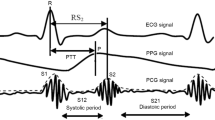Abstract
Objective. Our objective was to overcome the limitations of linear models of oscillometric blood pressure determination by using a nonlinear technique to model the relationship between the oscillometric envelope and systolic and diastolic blood pressures, and then to use that technique for near-continuous arterial pressure monitoring at the supraorbital artery.Methods. An adhesive pressure pad and transducer were used to collect oscillometric data from the supraorbital artery of 85 subjects. These data were then used to train an artificial neural network (ANN) to report diastolic or systolic pressure. Arterial pressure measurements defined by brachial artery auscultation were used as a reference. ANN results were compared with those obtained using a standard oscillometric algorithm that determined pressures based on fixed percentages of the maximum oscillometric amplitude.Results. The ANN produced better estimates of reference blood pressures than the standard oscillometric algorithm. Mean difference between target and actual output for the ANN was 0.50±5.73 mm Hg for systolic pressures, compared to the mean difference of the standard algorithm of 2.78±19.38 mm Hg. For diastolic pressures, the ANN had a mean difference of 0.04±4.70 mm Hg, while the mean difference of the standard algorithm was −0.34±9.75 mm Hg.Conclusions. The ANN produced a better model of the relationship between the oscillometric envelope and reference systolic and diastolic pressures than did the standard oscillometric algorithm. Noninvasive blood pressure measured from the supraorbital artery agreed with pressure measured by auscultation in the brachial artery, and may sometimes be more clinically useful than an arm cuff device.
Similar content being viewed by others
References
Forster FK, Turney D. Oscillometric determination of diastolic, mean and systolic blood pressure—a numerical model. J Biomech Eng 1986;108:359–364
Geddes LA. The direct and indirect measurement of blood pressure. Chicago: Year Book Medical Publishers, 1970
Loubser PG. Comparison of intra-arterial and automated oscillometric blood pressure measurement methods in postoperative hypertensive patients. Med Instrum 1986;20:255–259
Hutton P, Dye J, Prys-Roberts C. An assessment of the Dinamap 845. Anaesthesia 1984;39:261–267
Raftery E B. Technical aspects of blood pressure measurement. In: Handbook of Hypertension, vol 14. Amsterdam: Elsevier Science Publishers, 1991:55–71
Bruner JMR, Krenis LJ, Kunsman JM, Sherman AP. Comparison of direct and indirect methods of measuring arterial blood pressure, part III. Med Instrum 1981;14:182–188
Baker PD. Neural network processing of oscillometric waveforms and blood pressure estimation from the superficial temporal artery (PhD dissertation). Salt Lake City: Department of Bioengineering, University of Utah, 1990
Hornik K, Stinchcombe M, White H. Multilayer feedforward networks are universal approximators. Neural Networks 1989;2:359–366
Xue Q, Hu YH, Tompkins WJ. Neural-network-based adaptive matched filtering for QRS detection. IEEE Trans Biomed Eng 1992;39:317–329
Rumelhart DE, Hinton GE, Williams RJ. Learning internal representations by error propagation. In: Rumelhart DE, McClelland JL, eds. Parallel distributed processing, vol 1. Cambridge, MA: MIT Press, 1987:318–362
Kahaner D, Moler C, Nash S. Numerical methods and software. Englewood Cliffs, NJ: Prentice Hall, 1989:194–195
Yelderman M, Ream A. Indirect measurement of mean blood pressure in the anesthetized patient. Anesthesiology 1979;50:253–256
American National Standard for Electronic or Automated Sphygmomanometers. Association for the Advancement of Medical Instrumentation. American National Standards Institute, Inc, 27 Feb 1987
Further reading
Bailey D, Thompson D. How to develop neural-network applications. AI Expert 1990;5(6):38–47
Caudill M. Neural networks primer. Reprinted from issues of AI Expert, Miller Freeman Publications, San Francisco, 1989
Caudill M. Neural network training tips and techniques. AI Expert 1991;6(1):56–61
Lippman RP. An introduction to computing with neural nets. IEEE ASSP Mag 1987;4:4–22
Rumelhart DE, Hinton GE, Williams RJ. Learning internal representations by error propagation. In: Rumelhart DE, McClelland JL, eds. Parallel distributed processing, vol 1. Cambridge, MA: MIT Press, 1987:318–362
Author information
Authors and Affiliations
Additional information
This research was supported, in part, by a grant from Baxter Healthcare Corporation (Santa Ana, CA), and Innerspace Medical (Irvine, CA). A grant of computer time from the Utah Supercomputer Institute, which is funded by the State of Utah and the IBM Corporation, is gratefully acknowledged.
Rights and permissions
About this article
Cite this article
Narus, S., Egbert, T., Lee, TK. et al. Noninvasive blood pressure monitoring from the supraorbital artery using an artificial neural network oscillometric algorithm. J Clin Monitor Comput 11, 289–297 (1995). https://doi.org/10.1007/BF01616986
Received:
Accepted:
Issue Date:
DOI: https://doi.org/10.1007/BF01616986




